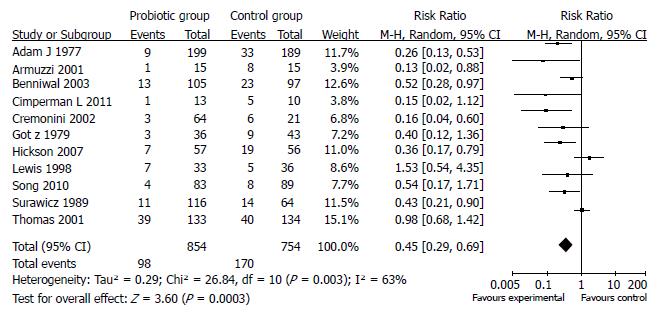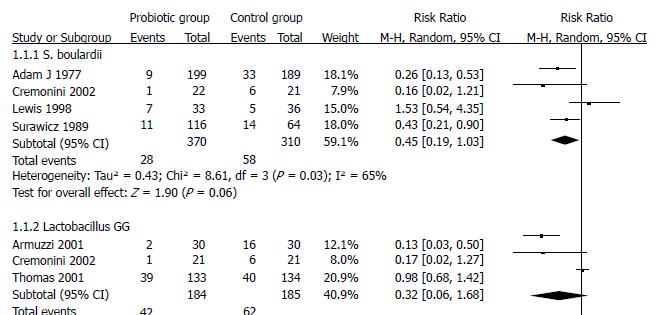修回日期: 2012-06-28
接受日期: 2012-07-20
在线出版日期: 2012-07-28
目的: 探讨益生菌的使用与成人抗生素相关性腹泻(AAD)的关联, 分析益生菌预防AAD的有效性及安全性.
方法: 系统检索PubMed, Embase, CINAHL, AMED, the Cochrane database of Systematic Reviews, the Cochrane Controlled Trials Register和中国期刊全文数据库(CNKI), 检索时间跨度从1966-01/2012-04. 我们只纳入随机对照试验, 研究对象>18周岁, 研究内容为服用抗生素的同时服用益生菌预防AAD.
结果: 本研究结果表明, RR = 0.45, 95%CI: 0.29-0.69, P<0.001, 益生菌可以显著降低服用抗生素后发生腹泻的机率. 基于益生菌种类的亚组分析的结果(RR = 0.42, 95%CI: 0.20-0.85, P = 0.003)同样证明了益生菌预防AAD的有效性.
结论: 益生菌可以显著降低服用抗生素后发生成人AAD的机率.
引文著录: 张春东, 戴冬秋, 赵哲明. 益生菌预防成人抗生素相关性腹泻的荟萃分析. 世界华人消化杂志 2012; 20(21): 2006-2011
Revised: June 28, 2012
Accepted: July 20, 2012
Published online: July 28, 2012
AIM: To systematically investigate whether current clinical trails can clarify the association between probiotic administration and adult antibiotic-associated diarrhea (AAD), and to evaluate the efficacy and safety of probiotic administration in preventing AAD in both inpatient and outpatient adults.
METHODS: PubMed, Embase, CINAHL, AMED, the Cochrane database of Systematic Reviews, the Cochrane Controlled Trials Register, and the China National Knowledge Infrastructure (CNKI) electronic databases were searched for studies published between January 1966 and April 2012. Only prospective, randomized, controlled trials involving patients older than 18 years were included. Furthermore, only the trials which combined antibiotic administration and probiotic therapy for the prevention of AAD were extracted.
RESULTS: The data of the present study showed a significantly decreased risk of adult AAD: relative risk (RR) = 0.45, 95% confidence interval (CI), 0.29-0.69, P < 0.001. Similar results were obtained from the subgroup analysis of particular types of probiotics (RR = 0.42, 95%CI: 0.20-0.85, P = 0.003).
CONCLUSION: Our study suggests that adult patients can benefit from probiotics co-administered with antibiotics.
- Citation: Zhang CD, Dai DQ, Zhao ZM. Probiotics for the prevention of antibiotic-associated diarrhea in adult patients: A meta-analysis. Shijie Huaren Xiaohua Zazhi 2012; 20(21): 2006-2011
- URL: https://www.wjgnet.com/1009-3079/full/v20/i21/2006.htm
- DOI: https://dx.doi.org/10.11569/wcjd.v20.i21.2006
目前, 世界范围内的抗生素滥用现象十分普遍, 此现象在中国尤其严重[1], 导致了以抗生素相关性腹泻(antibiotic-associated diarrhea, AAD)为主的一系列临床症状. Siegel等[2]统计, 美国仅仅在2011年, 消化系统新增肿瘤患者的数量就高达284 680人, 外科手术治疗仍然是目前治疗消化系恶性肿瘤的最重要手段, 而消化系统恶性肿瘤手术术后需要使用抗生素进行抗炎治疗, 一旦抗生素使用时间过长, 就可能引起AAD. 能引起AAD的抗生素种类繁多, 例如β-内酰胺类/青霉素类[3,4]、克拉霉素类[5]、大环内酯类[6], 尤其是抗厌氧菌类的抗生素如硝唑类[7]. 抗生素的使用可导致肠道菌群失调, 引起以腹泻为主的一系列症状. AAD的相关危险因素包括: 患者年龄、健康状况、抗生素使用周期的长短等[7,8]. 国外一些临床试验结果表明, 使用抗生素后AAD的发生率为3%-60%[7-9]. 另外, 文献报道[10], AAD严重时甚至可以导致患者死亡. 无论入院或门诊患者, 年轻或年老患者, 只要使用抗生素, 都有获得AAD的风险[11,12].
益生菌指奶制品或饮品中含有的那些对肠道有益的细菌, 他们能调节肠道微生态, 调整菌群比例, 降低AAD发生的机率. 另外, 益生菌也存在胶囊和粉末两种形态. Salminen等[13]将益生菌定义为: 能够调节肠道菌群并有益于人体健康的活的微生物. 这些益生菌调节肠道内"有益"与"无益"的细菌比例, 达到预防或改善肠道内菌群失调, 减少腹泻的发生率. 益生菌可以有效地改善腹泻性疾病[14], 同时, 也被证实可以用来改善便秘, 并逐渐受到越来越多的重视[15]. 临床中比较常用的益生菌产品有整肠生、金双歧等, 外科系统中, 胃肠外科使用此类产品较多, 疗效显著, 并可以推广使用.
临床有大量的研究证实, 在使用抗生素的同时服用益生菌, 可以有效地降低成人AAD的发生率. 在国外的一些随机对照试验(randomed controlled trails, RCT)中, 多种益生菌已经被证实可以预防成人AAD, 当然, 也有一些没有被证实[5,11,16-18]. Johnston等[19]的研究数据表明: 益生菌同样可以降低儿童使用抗生素后发生AAD的机率. 众多国外RCT研究证明了益生菌预防儿童AAD的有效性和安全性[9,10,16]. 然而目前尚无关于益生菌用于预防成人AAD方面的荟萃分析. 我们的荟萃分析恰恰是关于益生菌用于预防成人AAD并得出结论: 在使用抗生素的同时使用益生菌, 可以降低成人AAD的发生率.
电子检索了发表的以及未发表的文献, 检索的数据库及年限如下: PubMed(1966-2012), Embase(1980-2012), CINAHL(1982-2012), AMED(1985-2012), the Cochrane database of Systematic Reviews(1990-2012), the Cochrane Controlled Trials Register(1990-2012)和CNKI (1990-2012). 检索时间范围1966-01/2012-04, 我们只纳入那些关于益生菌预防成人AAD, 并同时具有前瞻性、随机性、对照性的试验.
1.2.1 文献检索: 主要包括汉语检索和英文检索, 收集国内外相关文献(含硕士、博士学位论文), 同时辅以文献追溯法. 此外, 我们从一些灰色文献中进行筛选, 例如, 会议摘要、被拒稿的文章等. 另外, 手工筛选一些即将发表、或被录用但暂未刊登的文章. 对于部分资料缺失的研究, 给作者致电或发邮件加以补充和完善. 检索关键词如下: (1)腹泻(diarrhea/diarrhoea/diarrh*/antibiotic-associated/antibiotic associated/antibiotic-associated diarrhea/AAD); (2)益生菌(probiotic*/yeast/milk*/kifir/ferment*/milk product*/yogurt*/bifidobacter/lactobacill*/streptococc*/enterococc*/LGG/Lactobacillus GG/lactococc*/saccharomyces*/b longum*/bidifobacter*/S. boulardii/Saccharomyces boularidii); (3)抗生素(anti-bacteri*/beta-lactam antibiotics/penicillins/cephalosporins/carbapenems/fluoroquinolones/macrolides/aminoglycosides/glycopeptides/tetracycline/azoles/amoxicillin/clavulanate potassium/cefprozil/clarithomycin); (4)治疗(treatment/therapy/biotherapeutic agent/cure/curing/treat/treating/prevent/prevention/prophylaxis/helpful/useful/effect/influence*/effectiveness/benefit*/improve*); (5)年龄(adult*/adult patients/adult people/adult man/man/men/woman/women/middle aged/old/old*/elderly/elderly*/people/person).
1.2.2 文献纳入和排除标准: 2名检索者(Zhang、Zhao)分别独立地进行检索, 包括关键词、标题、必要时检索全文, 对比检索结果, 经过讨论后决定取舍. 文献纳入及排除标准: (1)文献满足随机、对照、盲法(双盲或三盲), 病例类型为随机对照研究; (2)研究对象为年龄≥18岁人群; (3)文献内容须为益生菌预防抗生素相关性腹泻; (4)文献能直接提供RR值及95%CI, 或根据原始数据可以进行计算; (5)若有相同作者重复发表的研究数据, 只纳入资料信息最全的研究; (6)Jadad评分[20]高于1分, 且研究对象的失访率低于20%; (7)研究中发生腹泻原因非使用抗生素造成; (8)不限制研究对象的民族及国家, 亦不限定抗生素及益生菌使用的种类.
统计学处理 本研究采用Meta分析软件RevMan5.0对数据进行分析, 益生菌组和对照组的比较以RR值为效应指标, 异质性检验按α = 0.05标准对纳入的研究进行χ2检验. 若P>0.05, 则采用固定效应模型, 若P≤0.05, 则采用随机效应模型合并数据. 数据的合并方法采取Z检验, 按α = 0.05标准, 计算合并的RR值及95%CI. 检验发表偏倚采用漏斗图进行检测. 敏感性分析通过采用随机或者固定效应模型进行分析, 需找异质性来源, 最后对各研究进行相关性分析.
初级检索出1 157篇潜在满足条件的文章, 同时, 利用手工检索、Cochrane数据库、灰色文献及专家论坛等其他方面增加额外20篇文章, 总计1 177篇. 首先, 1 159篇文章被排除, 包括: 深入研究发现不是绝对相关, 或非RCT(n = 977), 重复(n = 117), 非AAD(n = 46), 进一步评价不满足其他条件(n = 19). 最后排除了7篇RCT(表1), 总计有11篇满足条件的RCT被纳入本研究.
所有被纳入的研究均为RCT. 11个研究共包括1 608名研究对象(实验组854人, 对照组754人). 在每一个RCT中, 益生菌的使用周期与抗生素的使用周期相同(7-14 d); 抗生素的使用目的包括: 输尿管感染, 上、下呼吸道感染、软组织或皮肤感染、消化系感染以及其他感染性疾病[4-6,11,22,28]; 研究对象的国籍包括: 美国[4,11,18,29,30]、英国[17]、韩国[6]、意大利[5,28]、土耳其[22]; 研究对象均为成年人(年龄≥18周岁); 研究对象包括住院患者[4,6,11,17]、门诊患者[18,28-30]以及医院内的工作人员等[5]; 抗生素的使用途径包括: 单纯口服、单纯静脉[11]或二者联合[6,11]. 11个研究中使用的抗生素包括单一抗生素应用[29]、2种或2种以上抗生素联合使用.
11个RCT中的益生菌使用方案包括: 布拉氏酵母菌(S. boulardii)[22,28,30], 鼠李糖乳杆菌(LGG)[4,5,28], 嗜酸乳杆菌[28], 嗜酸乳杆菌+保加利亚乳杆菌[29], 鼠李糖乳杆菌+嗜酸乳杆菌[6], 干酪乳杆菌+保加利亚乳杆菌+嗜热链球菌[17], 嗜酸乳杆菌+保加利亚乳杆菌+嗜热链球菌[11]等. 异质性检验结果(P = 0.02, I2 = 76%)显示各研究之间存在统计学异质性, 故采用随机效应模型. 按方案分析(PP分析)的结果(RR = 0.45, 95%CI: 0.29-0.69, P = 0.003)证明: 益生菌的使用可以显著降低AAD的发生率. 益生菌的每日用量从每日109-100×109菌落形成单位(colony-forming units, CFU).
本荟萃分析搜索策略严谨, 文章检索全面, 发表偏倚相对较低. Johnston等[19]报道益生菌可以预防儿童AAD, 然而我们的研究证明益生菌同样可以预防成人AAD, 并且无论是门诊或入院患者均可以通过服用益生菌而降低AAD的发生率.
本研究采用PP分析11篇RCT中共包含1 608名研究对象(益生菌组854人, 对照组754人). 各个RCT之间的异质性检验结果为: I2 = 63%>50%, P = 0.003, 因此, 我们采用随机效应模型, 得出的结果(RR = 0.45, 95%CI: 0.29-0.69, P = 0.0003)同先前一篇荟萃分析的结果(RR = 0.56, 95%CI: 0.44-0.71, P<0.05)一致[31], 证明了益生菌可以降低服用抗生素后发生AAD的机率(图1). 另外, 基于抗生素的种类, 本研究作了一个亚组的PP分析, 得到的结果S. boulardii(异质性检验: I2 = 65%, P = 0.03)、 LGG(异质性检验: I2 = 82%, P = 0.003), 表明抗生素种类的不同可能是各研究之间存在异质性的原因. 亚组分析得出的结果为: S. boulardii(RR = 0.45, 95%CI: 0.19-1.03, P = 0.06)、LGG(RR = 0.32, 95%CI: 0.06-1.68, P = 0.18), 益生菌组和对照组无明显的统计学差异, 可能是纳入的研究数目少, 样本量小, 存在发表偏倚等原因. McFarland等[32]的研究却证实了S. boulardii可以降低成人在服用抗生素后发生AAD的概率(图2).
本荟萃分析证明了使用抗生素的同时服用益生菌可以显著降低成人AAD的发生率, 结论与先前几篇荟萃分析的结论相似, 然而却有不同之处. 首先, 本荟萃分析中所有纳入研究的对象均为年纪>18岁的成人, 其他几篇荟萃分析的研究对象为成人和儿童[28,33]或者仅儿童[19,34]; 其次, 本荟萃分析讨论的不是单一益生菌的有效性, 而是将益生菌作为一个整体, 讨论其共同的效果, 这也区别于其他几篇荟萃分析[32-35].
为了进一步证实益生菌对于降低使用抗生素后AAD发生率的效果, 本研究又作了一个亚组分析, 发现单一菌种S. boulardii和LGG与对照组在降低AAD发生率上并未体现出显著的统计学差异, 只是表现出一个可以降低使用抗生素后发生AAD的趋势, 这个结果不同于McFarland等[32]的荟萃分析结果(RR = 0.47, 95%CI: 0.35-0.63, P<0.001), 这暗示我们多种益生菌联合使用的效果可能要优于单一菌种使用的效果, 此猜测在之前的荟萃分析中并未提出[32-35]. 为了证明单一菌种, 例如S. boulardii和LGG等对于降低使用抗生素后发生AAD的几率, 需要更多高质量的RCT.
在本荟萃分析纳入的11个RCT中, 未报道使用抗生素的同时联合服用益生菌发生严重不良反应(例如中毒、严重感染、死亡等)的案例, 证明服用益生菌预防AAD是相对安全的.
本荟萃分析有几个显著的优势: 我们不仅分析了益生菌作为一个整体, 并且同时分析了特定种类的益生菌对于预防AAD的有效性; 在进行文献检索前, 我们制定了一套严密的检索策略, 且文章纳入和排除的标准极其严格; 所有被纳入的研究均为RCT; 所有纳入的研究失访率均低于20%; 所有RCT均为双盲或三盲, 纳入的研究Jadad评分均>1分. 本荟萃分析的研究对象均为年龄>18周岁的成人, 使用抗生素的同时服用益生菌, 本研究包含先前荟萃分析中[6,18]没有引用的2个RCT研究.
本荟萃分析尚存在不足之处: 部分以法语、日语、德语等发表的文献并未检索; 文献并未采用意愿治疗分析(ITT分析); 部分RCT中未定义AAD及阐明抗生素使用的具体周期, 而我们认为这2个指标很重要, 甚至可以影响到试验的最终数据; 有文献报道[36-38]每日排便频率这一指标至关重要, 然而大部分RCT中并未提及. 另外一些指标, 例如, 研究对象的年龄、健康状况, 抗生素的种类等也是重要的影响因素, 以后的RCT研究应该充分考虑到这些因素, 纳入到评价的指标中; 11个RCT研究中提到的腹泻的定义不统一, 这势必会影响到判断阳性事件发生的数量. 因此, 未来的研究应采用一个共同的标准, 例如, 可以采用世界卫生组织(WHO)对于腹泻的定义; 倒漏斗图对于发表偏倚的检测十分关键, 我们的荟萃分析纳入的11个RCT, 7个RCT位于倒漏斗图的左侧, 4个位于右侧, 提示我们: 本荟萃分析存在一定的偏倚. 并非所有的益生菌的作用相同, 因此本荟萃分析中得出的结论未必适用于所有的益生菌.
益生菌可以降低胃肠手术使用抗生素[39]后发生AAD机率, 并且无论对于其他门诊或住院患者, 其作用都是有效且安全的. 本荟萃分析所纳入的研究中, 益生菌的平均使用周期为7-14 d, 每日用量为不少于108 CFU; 并未发现严重的不良反应事件. 未来需要更多高质量、大样本的RCT研究, 从而更加准确的分析益生菌预防成人AAD的有效性和安全性. 随着临床研究的不断深入, 以及益生菌产品的不断推新及推广使用, 相信AAD会得到越来越有效的控制.
近年来, 世界范围内的抗生素滥用现象普遍, 导致抗生素相关性腹泻(AAD)的发生率呈上升趋势, 而益生菌的合理使用在很大程度可以降低AAD的发生.
王俊平, 教授, 山西省人民医院消化科
目前市场上有以整肠生、金双歧等为代表的益生菌产品, 然而如何合理选择及如何正确使用益生菌产品需要深入研究.
在临床实践中, 往往在发生AAD后才会适当使用益生菌产品, 而本文得出的结论是益生菌与抗生素同时使用可以发挥最佳效果, 该结论可以指导临床实践.
益生菌可以广泛用于临床, 尤其是以胃肠外科为代表的外科系统, 降低外科术后使用抗生素后发生AAD的机率, 极大地改善患者的生存质量.
益生菌: 奶制品或饮品中含有的那些对肠道有益的细菌, 他们能调节肠道微生态, 调整菌群比例, 降低AAD发生的机率. 另外, 益生菌也存在胶囊和粉末两种形态.
本研究课题选取角度新颖, 符合当前研究热点, 文章的科学性、创新性和可读性能较好地反映胃肠病学临床研究的先进水平, 有一定的临床实用性.
编辑: 张姗姗 电编:鲁亚静
| 1. | Currie J, Lin W, Zhang W. Patient knowledge and antibiotic abuse: Evidence from an audit study in China. J Health Econ. 2011;30:933-949. [PubMed] [DOI] |
| 2. | Siegel R, Naishadham D, Jemal A. Cancer statistics, 2012. CA Cancer J Clin. 2012;62:10-29. [PubMed] [DOI] |
| 3. | McFarland LV, Surawicz CM, Greenberg RN, Elmer GW, Moyer KA, Melcher SA, Bowen KE, Cox JL. Prevention of beta-lactam-associated diarrhea by Saccharomyces boulardii compared with placebo. Am J Gastroenterol. 1995;90:439-448. [PubMed] |
| 4. | Thomas MR, Litin SC, Osmon DR, Corr AP, Weaver AL, Lohse CM. Lack of effect of Lactobacillus GG on antibiotic-associated diarrhea: a randomized, placebo-controlled trial. Mayo Clin Proc. 2001;76:883-889. [PubMed] |
| 5. | Armuzzi A, Cremonini F, Bartolozzi F, Canducci F, Candelli M, Ojetti V, Cammarota G, Anti M, De Lorenzo A, Pola P. The effect of oral administration of Lactobacillus GG on antibiotic-associated gastrointestinal side-effects during Helicobacter pylori eradication therapy. Aliment Pharmacol Ther. 2001;15:163-169. [PubMed] [DOI] |
| 6. | Song HJ, Kim JY, Jung SA, Kim SE, Park HS, Jeong Y, Hong SP, Cheon JH, Kim WH, Kim HJ. Effect of probiotic Lactobacillus (Lacidofil® cap) for the prevention of antibiotic-associated diarrhea: a prospective, randomized, double-blind, multicenter study. J Korean Med Sci. 2010;25:1784-1791. [PubMed] [DOI] |
| 7. | McFarland LV. Epidemiology, risk factors and treatments for antibiotic-associated diarrhea. Dig Dis. 1998;16:292-307. [PubMed] [DOI] |
| 8. | Bartlett JG. Clinical practice. Antibiotic-associated diarrhea. N Engl J Med. 2002;346:334-339. [PubMed] [DOI] |
| 9. | La Rosa M, Bottaro G, Gulino N, Gambuzza F, Di Forti F, Inì G, Tornambè E. [Prevention of antibiotic-associated diarrhea with Lactobacillus sporogens and fructo-oligosaccharides in children. A multicentric double-blind vs placebo study]. Minerva Pediatr. 2003;55:447-452. [PubMed] |
| 10. | Arvola T, Laiho K, Torkkeli S, Mykkänen H, Salminen S, Maunula L, Isolauri E. Prophylactic Lactobacillus GG reduces antibiotic-associated diarrhea in children with respiratory infections: a randomized study. Pediatrics. 1999;104:e64. [PubMed] [DOI] |
| 11. | Beniwal RS, Arena VC, Thomas L, Narla S, Imperiale TF, Chaudhry RA, Ahmad UA. A randomized trial of yogurt for prevention of antibiotic-associated diarrhea. Dig Dis Sci. 2003;48:2077-2082. [PubMed] [DOI] |
| 12. | Merenstein DJ, Foster J, D'Amico F. A randomized clinical trial measuring the influence of kefir on antibiotic-associated diarrhea: the measuring the influence of Kefir (MILK) Study. Arch Pediatr Adolesc Med. 2009;163:750-754. [PubMed] [DOI] |
| 13. | Salminen S, Bouley C, Boutron-Ruault MC, Cummings JH, Franck A, Gibson GR, Isolauri E, Moreau MC, Roberfroid M, Rowland I. Functional food science and gastrointestinal physiology and function. Br J Nutr. 1998;80 Suppl 1:S147-S171. [PubMed] [DOI] |
| 14. | Gratz SW, Mykkanen H, El-Nezami HS. Probiotics and gut health: a special focus on liver diseases. World J Gastroenterol. 2010;16:403-410. [PubMed] [DOI] |
| 15. | Chmielewska A, Szajewska H. Systematic review of randomised controlled trials: probiotics for functional constipation. World J Gastroenterol. 2010;16:69-75. [PubMed] |
| 16. | Corrêa NB, Péret Filho LA, Penna FJ, Lima FM, Nicoli JR. A randomized formula controlled trial of Bifidobacterium lactis and Streptococcus thermophilus for prevention of antibiotic-associated diarrhea in infants. J Clin Gastroenterol. 2005;39:385-389. [PubMed] [DOI] |
| 17. | Hickson M, D'Souza AL, Muthu N, Rogers TR, Want S, Rajkumar C, Bulpitt CJ. Use of probiotic Lactobacillus preparation to prevent diarrhoea associated with antibiotics: randomised double blind placebo controlled trial. BMJ. 2007;335:80. [PubMed] [DOI] |
| 18. | Cimperman L, Bayless G, Best K, Diligente A, Mordarski B, Oster M, Smith M, Vatakis F, Wiese D, Steiber A. A randomized, double-blind, placebo-controlled pilot study of Lactobacillus reuteri ATCC 55730 for the prevention of antibiotic-associated diarrhea in hospitalized adults. J Clin Gastroenterol. 2011;45:785-789. [PubMed] [DOI] |
| 19. | Johnston BC, Supina AL, Vohra S. Probiotics for pediatric antibiotic-associated diarrhea: a meta-analysis of randomized placebo-controlled trials. CMAJ. 2006;175:377-383. [PubMed] [DOI] |
| 20. | Jadad AR, Moore RA, Carroll D, Jenkinson C, Reynolds DJ, Gavaghan DJ, McQuay HJ. Assessing the quality of reports of randomized clinical trials: is blinding necessary? Control Clin Trials. 1996;17:1-12. [PubMed] [DOI] |
| 21. | Siitonen S, Vapaatalo H, Salminen S, Gordin A, Saxelin M, Wikberg R, Kirkkola AL. Effect of Lactobacillus GG yoghurt in prevention of antibiotic associated diarrhoea. Ann Med. 1990;22:57-59. [PubMed] [DOI] |
| 22. | Cindoruk M, Erkan G, Karakan T, Dursun A, Unal S. Efficacy and safety of Saccharomyces boulardii in the 14-day triple anti-Helicobacter pylori therapy: a prospective randomized placebo-controlled double-blind study. Helicobacter. 2007;12:309-316. [PubMed] [DOI] |
| 23. | Duman DG, Bor S, Ozütemiz O, Sahin T, Oğuz D, Iştan F, Vural T, Sandkci M, Işksal F, Simşek I. Efficacy and safety of Saccharomyces boulardii in prevention of antibiotic-associated diarrhoea due to Helicobacterpylori eradication. Eur J Gastroenterol Hepatol. 2005;17:1357-1361. [PubMed] [DOI] |
| 24. | Schellenberg D, Bonington A, Champion CM, Lancaster R, Webb S, Main J. Treatment of Clostridium difficile diarrhoea with brewer's yeast. Lancet. 1994;343:171-172. [PubMed] [DOI] |
| 25. | Gao XW, Mubasher M, Fang CY, Reifer C, Miller LE. Dose-response efficacy of a proprietary probiotic formula of Lactobacillus acidophilus CL1285 and Lactobacillus casei LBC80R for antibiotic-associated diarrhea and Clostridium difficile-associated diarrhea prophylaxis in adult patients. Am J Gastroenterol. 2010;105:1636-1641. [PubMed] [DOI] |
| 26. | Tankanow RM, Ross MB, Ertel IJ, Dickinson DG, McCormick LS, Garfinkel JF. A double-blind, placebo-controlled study of the efficacy of Lactinex in the prophylaxis of amoxicillin-induced diarrhea. DICP. 1990;24:382-384. [PubMed] |
| 27. | Wenus C, Goll R, Loken EB, Biong AS, Halvorsen DS, Florholmen J. Prevention of antibiotic-associated diarrhoea by a fermented probiotic milk drink. Eur J Clin Nutr. 2008;62:299-301. [PubMed] [DOI] |
| 28. | Cremonini F, Di Caro S, Covino M, Armuzzi A, Gabrielli M, Santarelli L, Nista EC, Cammarota G, Gasbarrini G, Gasbarrini A. Effect of different probiotic preparations on anti-helicobacter pylori therapy-related side effects: a parallel group, triple blind, placebo-controlled study. Am J Gastroenterol. 2002;97:2744-2749. [PubMed] [DOI] |
| 29. | Gotz V, Romankiewicz JA, Moss J, Murray HW. Prophylaxis against ampicillin-associated diarrhea with a lactobacillus preparation. Am J Hosp Pharm. 1979;36:754-757. [PubMed] |
| 30. | Surawicz CM, Elmer GW, Speelman P, McFarland LV, Chinn J, van Belle G. Prevention of antibiotic-associated diarrhea by Saccharomyces boulardii: a prospective study. Gastroenterology. 1989;96:981-988. [PubMed] |
| 31. | Avadhani A, Miley H. Probiotics for prevention of antibiotic-associated diarrhea and Clostridium difficile-associated disease in hospitalized adults--a meta-analysis. J Am Acad Nurse Pract. 2011;23:269-274. [PubMed] [DOI] |
| 32. | McFarland LV. Systematic review and meta-analysis of Saccharomyces boulardii in adult patients. World J Gastroenterol. 2010;16:2202-2222. [PubMed] [DOI] |
| 33. | Hawrelak JA, Whitten DL, Myers SP. Is Lactobacillus rhamnosus GG effective in preventing the onset of antibiotic-associated diarrhoea: a systematic review. Digestion. 2005;72:51-56. [PubMed] [DOI] |
| 34. | Szajewska H, Mrukowicz J. Meta-analysis: non-pathogenic yeast Saccharomyces boulardii in the prevention of antibiotic-associated diarrhoea. Aliment Pharmacol Ther. 2005;22:365-372. [PubMed] [DOI] |
| 35. | Kale-Pradhan PB, Jassal HK, Wilhelm SM. Role of Lactobacillus in the prevention of antibiotic-associated diarrhea: a meta-analysis. Pharmacotherapy. 2010;30:119-126. [PubMed] [DOI] |
| 36. | Johnston BC, Supina AL, Ospina M, Vohra S. Probiotics for the prevention of pediatric antibiotic-associated diarrhea. Cochrane Database Syst Rev. 2007;CD004827. [PubMed] |
| 37. | [Controlled double blind clinical trials of lyophilized Ultra-Levure. Multiple-center study by 25 physicians of 388 cases]. Med Chir Dig. 1976;5:401-406. [PubMed] |










